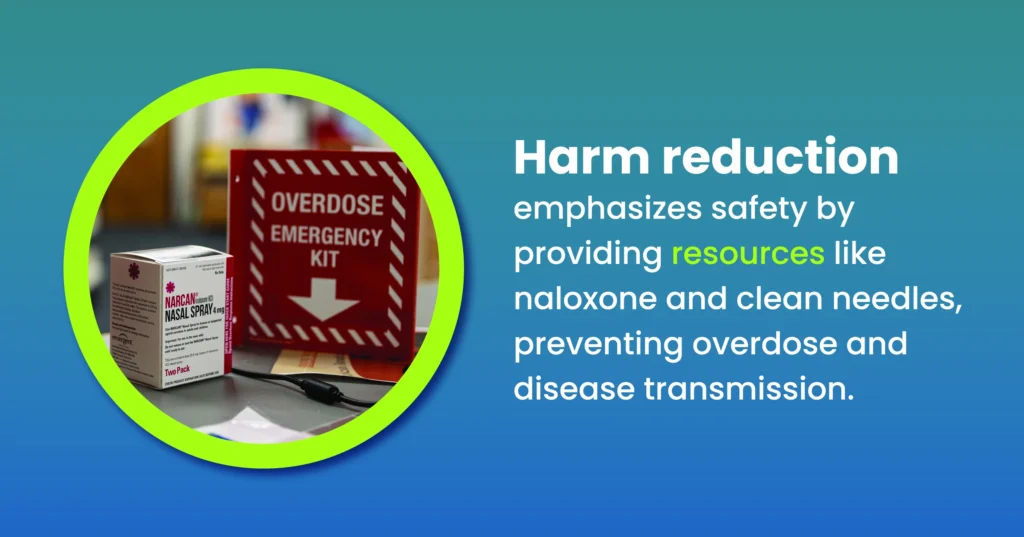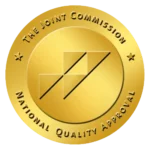Harm reduction strategies focus on minimizing the harmful effects of substance use. These approaches aim to enhance safety and promote healthier choices without judgment.
Instead of solely urging abstinence, they acknowledge that some people might continue using substances. Examples include needle exchange programs, providing naloxone to prevent opioid overdoses, and supervised injection sites.

These strategies prioritize health, offering support and resources to reduce risks linked with substance use. They are crucial in curbing the spread of infections like HIV and Hepatitis C while also connecting individuals with medical, mental health, and social services.
Key Takeaways
Harm reduction measures aim to lessen the negative impacts of substance usage. These methods seek to increase safety and support wholesome decisions without passing judgment.
- Harm reduction strategies focus on practical steps to reduce the negative impact of substance use.
- Harm reduction emphasizes safety by providing resources like naloxone and clean needles, preventing overdose and disease transmission.
- Harm reduction offers a range of strategies, including supervised injection sites, education, and counseling, catering to individual needs.
The Haven Detox-Little Rock can aid you in substance abuse recovery. Contact us at (501) 271-3342 and choose a healthy recovery.
Prevalence of Drug Abuse
The extent of drug abuse is essential to understand when talking about the prevalence of drug abuse. In the United States, around 19.3 million adults battled substance use disorder in 2020. It translates to about 7.4 percent of adults aged 18 and older. When we talk about substance use, it includes both illegal drugs and the misuse of prescription medications.
To break it down further, approximately 7.9 million people struggled with illicit drug use disorders, while 12.9 million had issues with alcohol. Misusing prescription pain relievers affected around 2.7 million individuals. These statistics highlight that substance use disorders are more common than we might think, impacting people from all walks of life.
It’s important to remember that these numbers aren’t just statistics. They represent real lives and families. Substance use disorders can take you to serious health problems, strained relationships, and difficulties at work or school.
However, the good news is that help is available. The first step in managing drug abuse is understanding its prevalence and supporting those in need.
Principles of Harm Reduction
Harm reduction is based on simple yet powerful principles. It’s about accepting that some people will use substances and aiming to reduce harm while promoting safety. Here are the fundamental principles:
Human Rights and Dignity: Every person deserves respect and support, regardless of substance use. Stigmatization and discrimination hinder progress.
Meet People Where They Are: Harm reduction meets individuals at their current stage without pushing for immediate abstinence. It builds trust and encourages positive change.
Non-Judgmental Approach: Judging doesn’t help. A caring, non-judgmental attitude fosters open communication and willingness to seek help.
Safety First: Prioritizing safety involves providing clean supplies, preventing overdoses, and offering education on safer substance use practices.
Health Promotion: Harm reduction focuses on improving overall well-being. It includes access to medical care, mental health support, and resources for healthier living.
Community Involvement: Community-based efforts empower individuals. Involving them in decisions ensures that programs and policies address real needs.
Flexible Goals: Goals are individualized. Reduction in substance use, improved health, and enhanced quality of life are all valuable achievements.
Access to Treatment and Support: Access to treatment, counseling, and support services ensures that individuals can seek help when ready.
Continuous Learning and Improvement: Harm reduction adapts based on evidence and feedback. It ensures effective and relevant strategies.
Collaboration: Government, healthcare, community organizations, and individuals work together for a comprehensive approach.
Always remember harm reduction recognizes the complexity of substance use. It offers practical solutions that respect each person’s journey toward better health and well-being.
Types of Harm Reduction Strategies
Harm reduction strategies encompass various approaches to minimize the adverse effects of substance use. Here are some common types:
Needle and Syringe Programs
Needle and syringe programs (NSPs) are essential harm reduction initiatives. These programs offer a safe place for individuals who inject drugs to swap used needles for clean ones.
By doing this, NSPs significantly reduce the risk of infections like HIV and Hepatitis C that can spread through shared needles. These programs also provide education on safer injection practices and offer referrals to healthcare and support services.
The programs create opportunities for individuals to connect with trained experts who can provide guidance and resources. NSPs not only protect the health of individuals who use drugs but also contribute to overall community well-being by preventing the transmission of diseases.
Opioid Agonist Therapy
Opioid agonist therapy (OAT) provides a stable foundation for recovery, managing both the physical and psychological aspects of opioid dependence. It is a proven approach to treating opioid use disorder. It involves using medications like methadone, buprenorphine, or naltrexone to help control cravings and withdrawal symptoms.
OAT is effective because these medications interact with the same receptors as opioids, reducing cravings and withdrawal discomfort. It allows people to focus on recovery without the overwhelming urge to use opioids.
OAT is combined with counseling and support services for comprehensive treatment. Comprehensive harm reduction services and drug treatment can prevent opioid overdose risks at your side.
Overdose Prevention and Response
Overdose prevention and response is a vital harm reduction strategy. It focuses on saving lives by providing training and access to naloxone, a medication that can rapidly reverse opioid overdoses.
Naloxone kits are distributed to individuals who use opioids, their friends, families, and community members. Training is straightforward and empowers people to identify the signs of an overdose and allocate naloxone promptly.
Communities, healthcare providers, and emergency responders work together to ensure naloxone is readily available. They contribute to a safer environment for those affected by opioid use.
This strategy has been crucial in reducing opioid-related deaths across the United States. It is a powerful tool in harm reduction, ensuring that those at risk and their communities are equipped to respond effectively to overdose emergencies.
Safe Injection Facilities
Safe injection facilities are controlled spaces where individuals can use pre-obtained drugs under medical supervision. These facilities prioritize safety by offering sterile equipment, preventing overdoses, and reducing the risk of infections. They provide a bridge to healthcare, counseling, and support services, fostering opportunities for individuals to seek treatment when ready.
Safe injection facilities are part of harm reduction strategies that acknowledge the realities of substance use and aim to minimize harm while promoting health. While controversial in some areas, evidence shows they can reduce public drug use, improve community well-being, and save lives by preventing fatal overdoses.
Drug Checking Services
Drug-checking services play a crucial role in preventing dangerous substances from circulating. They provide an opportunity for outreach and education about safer substance use practices.
The services allow users to assess the content and purity of substances they intend to ingest. These services use advanced technology to analyze samples and provide information about potential risks. They empower individuals to make informed decisions, reducing the chances of accidental overdose or adverse reactions. While drug checking doesn’t promote drug use, it recognizes the reality of substance consumption and strives to enhance safety.
Drug-checking services provide accurate information on substances, reducing harm and liability associated with drug use. They are a valuable resource for individuals who use drugs to reduce potential health risks.
Effectiveness of Harm Reduction Programs
Harm reduction programs have demonstrated their effectiveness in various ways. They have been shown to reduce the spread of infectious diseases like Hepatitis C and HIV among drug users. These programs also help decrease overdose fatalities by providing naloxone and creating supervised spaces for drug use.
Moreover, harm reduction initiatives foster connections to healthcare and support services, encouraging individuals to seek treatment and make positive life changes. These programs engage individuals who might otherwise avoid traditional treatment approaches by focusing on practical strategies and non-judgmental support.
Research indicates that harm reduction contributes to public safety by reducing drug-related crime and improving community well-being. Additionally, these programs can lead to cost savings for healthcare systems by preventing costly medical interventions associated with drug-related complications.
Harm reduction is not a one-fit solution but rather a collection of adaptable strategies that meet people where they are in their substance use journey. While abstinence-based treatments are essential, harm reduction provides a realistic and compassionate approach for those who continue to use substances. Its effectiveness lies in its holistic focus on health, safety, and social well-being, making it a valuable component of addressing substance use in society.
Frequently Asked Questions (FAQ)
What are the 4 Cs of substance use disorder?
The 4 C’s of substance use disorder are craving, control loss, compulsive use, and continued use despite harm. These four aspects highlight the key elements that characterize substance use disorder.
People with this disorder experience intense cravings for the substance, lose control over their consumption, continue using despite adverse consequences, and often find themselves in a cycle of compulsive use. These factors collectively define individuals’ challenges when dealing with substance use disorder.
What are the three levels of prevention for substance abuse?
The three levels of prevention for substance abuse are primary, secondary, and tertiary.
Primary prevention focuses on preventing substance use before it starts. It aims to create awareness, education, and policies discouraging initial substance experimentation.
Secondary prevention involves early intervention for individuals at risk of developing substance use disorders. It aims to identify and address problematic substance use before it becomes severe.
Tertiary prevention concentrates on supporting and treating individuals with a substance use disorder. It aims to prevent relapse, promote recovery, and minimize the negative consequences of ongoing substance use.
What is harm reduction for drug addiction?
Harm reduction for drug addiction is a compassionate approach that prioritizes minimizing the negative consequences of substance use. It focuses on practical strategies such as needle exchange programs, supervised injection sites, and access to naloxone to prevent overdoses.
The goal is to enhance safety, improve health, and foster connections to medical and support services while recognizing the complexities of substance use. It doesn’t demand immediate abstinence but supports individuals in making healthier choices and reducing risks associated with their drug use.
Reduce Substance Harm With The Haven Detox-Little Rock
The Haven Detox-Little Rock employs harm reduction approaches to substance abuse, focusing on your safety and health. Also, if substance abuse has taken a toll on your well-being and you seek effective harm-reduction strategies, consider our facility your best partner.
We offer comprehensive services, including detox and residential care tailored to your needs. Our expert medical staff is trained to provide personalized care programs to create a supportive and safe environment for your recovery journey.Stop delaying now and contact us today at (501) 271-3342 to take the initiative towards a safer and healthier future.



